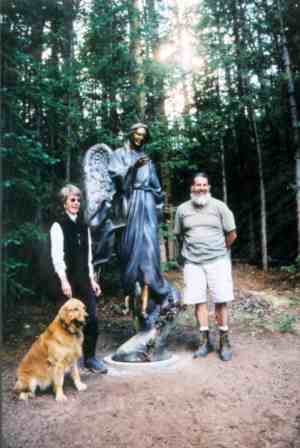Article by Marcia Darnell
Local artists – December 2002 – Colorado Central Magazine
ANYONE WHO HAS ASCENDED past the stations of the cross in San Luis has seen the work of sculptor Huberto Maestas. The 15 larger-than-life statues depict the final journey of Christ for the faithful, and their grace and power provide inspiration even for those whose climb is more a physical workout than a meditation.
Maestas’ work adorns churches from Phoenix to Denver, from Texas to Kentucky, and from Dodge City to L.A., and miniatures of his stations statues are part of the Vatican collection.
But don’t call him religious.

“I’m more spiritual than religious,” he says. “Sometimes I feel that the human spirit touches my hands.
“I’m religious about my artwork.”
Maestas is native to the San Luis Valley, and says he became an artist “because I didn’t want to be a farmer.” He started sculpting at age 10. After completing an art degree at Adams State College, he lived in Colorado Springs for 12 years, then moved to San Luis in 1988 to work on the stations of the cross, which were commissioned by the local parish. He calls the job “an ongoing project.” More pieces are planned for the trail to the chapel.
His art studies began with classes in engineering and architecture, which he says helps with his work.
“A lot of engineering goes into these big pieces,” he says.
Each begins with sketches. “Drawing is the foundation for all the arts,” he says. “You can see your ideas.”
Employees, some of them his children, help in the foundry, but Maestas keeps a hand in all the process, through casting and finishing. After college he worked in foundries in Santa Fé and Colorado Springs.
“I learned more there about this process than anywhere else,” he says. His finished works range in size from 3 inches to 30 feet in height.
He creates lots of commissioned works.
“They give me the image, and I try to bring the humanity into it.” He says symbolism is crucial. He creates a lot of work for churches, meaning those sculptures are more than just images.
“When I’m doing my artwork, I’m trying to convey human experience, just the experiences we have as people,” he says.
Unlike most regional artists, Maestas says it’s unimportant where he abides. “It would not matter where I live,” he says. “I’m an artist not affected by my surroundings. Maybe if I were a painter, it would. As a matter of fact, come wintertime, I can’t stand it here.”

Seeing other places is important, though. Maestas and his wife, Dana, travel throughout the United States and Mexico frequently, and to Europe as well.
“My sculpture is not affected by New Mexico santos, but more by Europeans,” he says. “It’s more Huberto than New Mexico.”
And Huberto is versatile. His ouevre includes depictions of wildlife, nudes, figurative art, and Southwestern images.
The Maestas studio includes works for sale by other artists, replicas of the stations statues, and other images of humans in emotional tumult. Visitors can also see photos of Maestas’s other works, and of the artist being presented to Pope John Paul II.
Huberto and Dana have four grown children, one of whom, Bianca, is a painter and photographer. Her work also hangs in her father’s studio in San Luis.
Maestas’ work is available at his studio, Huberto’s Sculpture Studio, (719) 672-3022. “We’re usually open,” he says. And his work is also on display at Taos Nichols Fine Art Gallery.
Maestas works on multiple projects at once, and is currently sculpting and drawing several pieces. He also wants to start making prints and lithographs.
Why does he keep working? “Because I’m an artist and I do artwork.”
“I’ve been an artist for 26 years,” he says. “It doesn’t seem that long.”
Marcia Darnell writes in a cat-controlled house in Alamosa.

